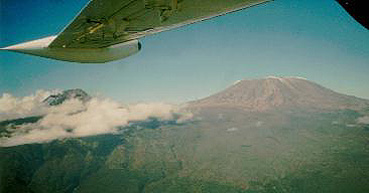 |
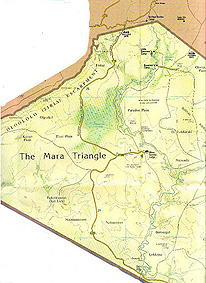 |
|
|
|
THE BIG FIVE
Safari into Masai Mara National Reserve 2002
I wanted to surprise my wife Ljiljana during our 3-week
sojourn at the South Coast of Mombasa end of January 2002. Without any
advance warning I booked a 3-day flight safari to 2 nights at recently
refurbished Kitchwa Tembo Tented Camp (short "KT"). Kitchwa Tempo (means
Head of Elephant) is located just outside of Oldololo Gate that is the
northern entrance to the Mara Triangle of Masai Mara National Reserve western
region.
 |
 |
|
|
|
We boarded a charter aircraft at Ukunda airstrip that is close to the township of Ukunda. At the junction of Mombasa main road there is the access to most Hotels situated on South Coast. The charter aircraft takes some two dozen of passengers and the flight duration depends of how many landings en route are required on to various camps en route. The day was sunny and warm but some turbulence could be expected particularly when we flew close to Kilimanjaro northern slopes. I was sitting a single seat at left row from where I had a splendid view on the majestic Kilimanjaro. Its two peaks were clearly visible: first Mawenzi rugged rocky form followed by Kibo peak that is the crater itself under a snowy crown sometimes. I was so much occupied taking photo that I didn't notice my wife's troubled mood. There were some disturbances too that increased any time when the aircraft descended to land on an airstrip. First we landed close to the camp "Keekorok Lodge" and the next landing was at "Intrepids" camp. The last 3rd descend was to the Kitchwa Tempo airstrip after about 3-hour flight.
A "Land-Rover" vehicle was waiting for us and the luggage
was loaded instantly. Soon we set of for a short cruise close to Mara River
swampy area and "Little Governor" camp from where start the balloon cruises
(at a price of US$500 pp). Joel, our driver cum guide explained that he
has to wait for another aircraft before we go for lunch to "KT". Right
away we came across several groups of Tomson's gazelles and Impala antelopes,
giraffes and a larger troupe of Banded Mongoose stopped, stood up watching
us for a while proceeding in their track after. Cameras and camcorders
zoomed and everybody was enthralled with the scenery. Suddenly Joel spotted
a cheetah prowling after a gazelle. Not far away two of her almost grown
cubs were watching intently how their "mama" would get food for them. Excitedly
we started talking about the prospects of seeing all of the "BIG FIVE"
during next outings.
 |
 |
 |
 |
 |
The BIG FIVE are the following animals: Buffalo, Elephant, Leopard, Lion and Rhinoceros. The "KT" safari vehicles are equipped with four benches that are arranged at different levels and the lowest one is for the driver. Thus a maximum of 7 passengers sits in pairs on each bench having an unobstructed view to the both vehicle sides. The car roof is fixed so it isn't necessary to stand up to take pictures at all. Most of the vehicles have an opening in the roof and one has stand up to take pictures that was always annoying as I experienced on previous safaris.
After a while Joel drove us out of the Mara Triangle Reserve though the Oloololo Gate on C13 main road to Kericho and Nairobi. After road crossing over a bridged brook we turned right of and downhill into a forested belt encompassed with a high wire fence. The narrow and winding road leads to clearing at forest's other side from where we entered the camp's reception. Only now one could see Mara River's path mostly hidden by trees and bushes winding through Olpunyata Swamp and Paradise Plain opposite of. After completing checking-in formalities we followed an attendant carrying our luggage to the assigned tent for us. The best tents are erected mostly between tree trunks in a wide semicircle at the forest's edge. From these tents one views on a flat ground of mowed grass that is "fenced-in" by thorny bush branches. Beyond the natural fence and some 50m downhill starts the Masai Mara National Reserve.
We left our belongings in the tent, closed carefully the
flaps with a strong zipper and returned to the restaurant for lunch. The
restaurant and large sitting room are located at one side and next to the
reception and opposite of which is a shop and service place for guests
using the swimming pool. All these buildings are constructed with natural
materials well hidden at forest's threshold wide opened viewing southwards
onto plains of Mara River. After lunch we returned to our tent at the far
end of first row following a paved path under shadowy trees as the sun
burned mercilessly in open. More tents were between trees as in a second
row and some of them were at the far compound's end closest to the thorny
fence.
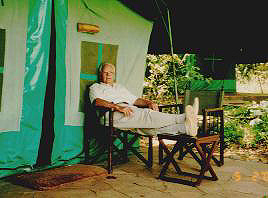 |
|
The tents were luxuriously outfitted compared to those ones we have had on previous safaris. Each tent roof had a twin canvas layer with a gap of some 30cm providing a perfect isolation by free moving air in between. The floor canvas rested on soft sandy draining layer and linked to walls and inner roof canvas too. The tent wings in front had zips to close wings themselves and with the floor, thus preventing any kind of inquisitive "dudus" (in Swahili anything creeping including insects). The living compartment had two wide beds, cupboard and bed tables and several "windows" with mosquito nets and zipped flaps for closure. A pleasing "bathroom" attached to it had a flushing toilette, shower and wash basin with running warm water as well as some other utensils. The single canvas roof had a translucent frame incorporated allowing faint light only.
After unpacking to make our stay here rather comfortable
there remained some time to rest for a while until the call for a sightseeing
tour at 16h. Not for long there was some commotion and running up on the
outer roof canvas. The carefully carried out inspection showed that a band
of Velvet monkeys took pleasure resting in a canvas "bed" during the warmest
day hours. Later in Joel's car we were five now as an elderly lady doctor
(she joined in because we persuaded her back in our same hotel) with the
two couples from before lunch. Short after entering Oloololo Gate Joel
turned of main road E176 onto a track leading into Olpunyata swampy region
that is liable to flooding during wet season.
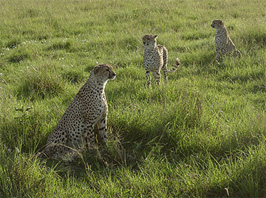 |
|
We came rather close to Mara River several times looking
for lions that we found at last deep in grass not pleased with our approach.
We've seen many giraffes, antelopes and wide variety of birds, a larger
group of elephants including a few lonely bulls. One of bulls was grazing
contently but when our vehicle came closer started flapping with his huge
ears and lifted ominously his trunk. Joel explained that his "friend" knows
too well him and so it would be better to get away before he comes after
us. On way back we came across "mama" cheetah and her two cubs resting
quite apart for her but she flashed her teeth, as she didn't want to be
disturbed by photographing. We ere back to the camp at dusk in time to
get ready for dinner taking a shower first and change into better clothing
too. After a pleasant dinner guests were invited to attend a lecture about
the research work going on the Reserve that accompanied a slide-show. Being
well acquainted with these matters we decided backing off to our beds being
tired after a long day's many attractions. It was a tranquil night accompanied
by wildness' sounds somewhere near or far away.
 |
|
After early morning tea served in our tent we drove out without breakfast to observe animals coming out of their night lairs. It was bitter cold despite all warm cloth we had pulled on and were longing for the sunrise to warm our stiff bodies. A new elderly English couple joined our group from yesterday so all Rover's seats were occupied. Later Joel took of the main road E176 driving slowly into the Eluai Plain at about say 1.500m ASL getting into the Olpurkel region below the Oloololo Escarpment of +1.700m ASL. He followed a line of bushes and small trees along a shallow gully when out of nowhere a large Eland antelope came out trotting onto the meadow some 30m in front of us. A rhinoceros followed it after trying hard to keep up to the antelope's trotting pace soon. We pulled out cameras or camcorders to record this quite uncommon symbiosis. The whole scene lasted probably 30 seconds before this incongruent pair disappeared behind bushes and out of our sight. Joel turned the car and drove back to intercept the animals but we could see rhino's rear hurrying after "his" antelope. Close together both animals crossed the main road and vanished into deep bushes far away.
What were the reasons for such a strange symbiosis between the two completely different animals? The probable explanation for such a behavior could be the animals' different wants and abilities. The Eland antelope (a mighty male) is a rather shy animal having excellent senses of hearing and a good sight knowing well the local feeding grounds. The rhinoceros (a young female of about 5 years) certainly would depend upon the antelope's qualities such as good sight and knowledge of good pastures, while in return she protects the antelope of any predator.
By mere coincidence we came upon the same couple of animals returning to "KT" in late afternoon. The same pair was on the way to their night place of retreat with the Eland antelope trotting some 50m in front of the rhino. Both animals were passing not far away from the vehicles that were going the same way when a van appeared and turned of the main road towards the trotting couple. The antelope had to swing slightly away speeding up to cross the road at another place. The rhino couldn't travel as fast as its companion and had to slow down panting and lost sight of the Eland antelope. All vehicles stopped instantly, so the rhino could proceeded at a slower trot in same direction as before, anticipating that she might find the Eland somewhere. True, there was the Eland that stopped shortly after crossing the main road and turning back and waited for his slower companion at a safe distance. As soon the rhino crossed the road, both animals moved out of the sight hiding in dense bushes. This was the end of a quite unusual observation of the symbiosis between an Eland antelope and a rhinoceros.
However, after our first encounter with this disparate
pair of animals, Joel wanted to show more in the Mara Triangle where we
toured during still early day. He followed one of the almost dry brooks
with scattered bushes both sides when out-of-nowhere a pair of Black-backed
jackals sprung out and rushed away. A moment later somebody spotted something
moving behind a bush and Joel moved slowly that way when a large lion appeared
his tail high up (that was spotted!) urinating to mark his territory. Joel
advanced very slowly to find two grown up lions sharing a grassy lair between
bushes exposed to early morning sun now. Slowly the car came around giving
a splendid view onto two large lions rubbing gently neck-to-neck. Photographer's
heart - what do you want more?
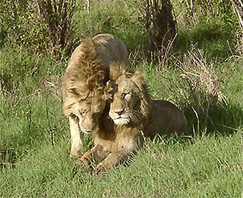 |
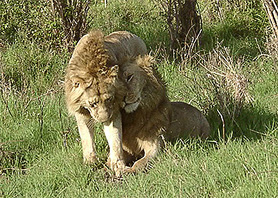 |
Quickly passed the morning hours and the going up sun made us feel warmer at the time progressed. Then one would take of one by one part of the clothes - like "shelling of onion leaves". We were craving after having a meal so one expected brunch boxes to be hidden somewhere in Joel's van. Back on the graveled road E176 we drove on southwards until we passed the liable flooding section and turned left onto an earth track well south of Olpunyata swamp. Interspersed on grassy plains grazed flocks of zebras, wildebeests, impalas and smaller gazelles. At right was small hill with a few trees from where groups of baboons came down to warm themselves on exposed rocks. After awhile Joel stirred the car onto a high bank of Mara alias Enkipai River where he stopped near some bushes. Then he declared that breakfast time is due and we should make ourselves comfortable meaning, "use the bush for toilette". Unfortunately he didn't warn ladies to watch their steps because ants were everywhere - they learned about this unpleasantness soon.
Joel opened vehicle's rear compartment where brunch boxes
were stacked properly and protected by a dozen of woolen blankets. Astonished
we protested about not having used the blankets but Joel guiltlessly responded
that nobody told him about "freezing" earlier. There were flasks with warm
coffee and tea so we could warm our internals at least now - after 9 o'clock
it became quite warm at the picnic place now. The picnic site was next
to the Kiboko Crossing (wildebeest) clearly marked with a wide ramp down
to the river whereas the opposite bank was low and almost flat beyond.
The flow of Mara River makes here several pools with some large rocky islands
protruding out of water. In the nearest pools basked some dozen of hippopotamuses.
A few crocodiles sunbathed on rocks or just put leisurely the jaw on a
rock still floating in the wake of water flow. A moment later a hippo ambled
out of water walking up a ramp of Kiboko Crossing (thus "Hippo") where
we're having our breakfast. Luckily for us that hippo choose to graze,
what was strange in full daylight, on a meadow at Crossing's opposite side.
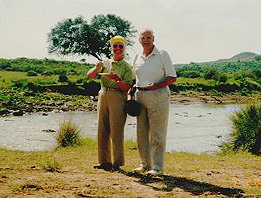 |
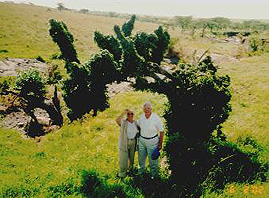 |
The breakfast was a striking event for all seven of us
- standing around or sitting on a suitable place in open nature surrounded
by animals not caring for us at all. Time was running out for our fellow
companions who would leave the camp after having lunch. On the return trip
we drove on an earthen track winding close along Mara River on its higher
bank where we'd seen a variety of many water birds resting in bushes or
on few trees. Later that road transverse Olpunyata Swamp becoming muddy
and slippery at few places bypassing shallow waters. During wet seasons
or after heavy rains one cannot drive along this route even with a 4-wheel
driven vehicle. Back in the camp folks leaving with early afternoon aircraft
went straight to the restaurant as they had packed their belongings that
waited neatly stacked up at the reception already. We went to our tent
via forest path first to return to the restaurant a little bit later. A
family of warthogs about dozen strong grazed happily close to the reception
area and swimming pool on freshly mown grass there. Of course, guests'
camera were clicking and few braver one went out to make better pictures
or close-ups of these tame warthogs that are normally rather shy and alert
to the approach of humans or other predators. After lunch we returned to
the tent to have a nap and rest until the afternoon outing called for at
16h.
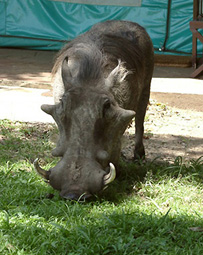 |
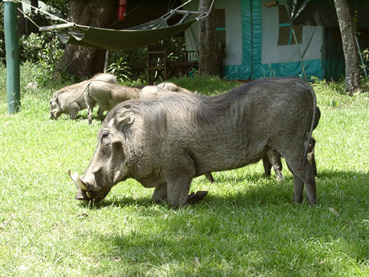 |
Walking along shadowy path behind the front tents we arrived to our tent at the time when the group of warthogs moved there too. One built an elevated bird's watering place some 6m in front of our tent that stood dry now. A warthog sow came closer to drink but turned away when my wife decided to bring water from the washbasin in our tent. She emptied two bottles at hand in shallow basin and returned for more when the sow returned to drink from it. The sow didn't go away when Ljiljana returned and emptied again the bottles and went back to fetch more. The dominant sow had enough and joined the boar that passed nearby on his way down to the river where the lowest of tents were placed. Another sow came to drink but followed the rest of group with few piglets too. [A week later we learned from a hotel guest who stayed in one of those lower tents that a mighty python caught one of the piglets. Camp visitors rushed down there and watched how the python devours his catch headfirst.]
Suddenly out of nowhere a band of some Banded mongoose
appeared and the leading male sniffling water jumped up into the shallow
basin now full of water. This large mongoose took a good bath and jumped
down and rolled in grass for a while. Then run to a low tree stump close
to our tent and started rubbing its felt on bark to dry and ended the whole
"process" by sun basking on top of the stump. This process followed several
mongooses with certain quarrellings obviously depending upon the order
of precedence. Only when the leading male voluntarily stopped lazing in
sun and left few other tried to copy the leader's leisure for a short time
but decided to join in with the group that was leaving for good. The both
scenarios could last more than 30 minutes. I was so exhausted running around
to take pictures and recording on tape the animal behavior from best possible
point of view. When everything was over I needed a shower and some rest
before go out in about an hour.
 |
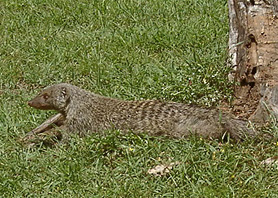 |
In the afternoon Joel got four new passengers that were all elderly Germans - a couple and two sisters - who wouldn't be as communicative and enthusiastic as our companions of before. First Joel zigzagged through the Eluai Plain west sides of the graveled road E176 and crossed into the areas of Olpunyata Swamp later. A lioness appeared with 3 cubs trotting unhappy behind her along a dry brook. A later further three lionesses relaxed in the shadow of a large bush and a well-concealed lion slept almost invisible in a bush groove. In dry savanna we passed close by groups of gazelles and other kind of antelopes with few larger ones like topis and wildebeests and zebras. In swamp's dryer regions few large herds of buffalo stood still ruminating but Joel wouldn't get too close to them, as the large bulls were constantly on guard looking rather ominous at any vehicle passing their way. Closer to Mara River unexpectedly the car got too close to a lioness' lair where we were greeted by muffled growls and clenching teeth. Giraffes nibbled at acacia trees nearby and little bit further a smaller group of elephant mothers with youngsters wadded through bushes and woods that grow along the banks of Mara River. We have seen many birds of prey and other kinds of but it would take too long to account for all of them. Of course, there was the second meeting of the extraordinary couple of animals - the Eland antelope and the rhinoceros ("kifaro")- as described before.
Towards the end of this afternoon long cruise we started teasing Joel that he has shown us the Four of the Big Fives only. He'd keep his word to find the Fifth one that is the leopard or "Chui" tomorrow at last - Joel promised. It was rather late when we returned to the camp in darkness already. Before the dinner a group of local Masai performers in their warrior's festive attire sang and danced in front of a campfire. Viewers had to choose either to be smoked in or bitten by merciless mosquitoes breeding in nearby swimming pool. After the performance of Masais spread blankets around the campfire putting on view their home made products for sale to tourists. They didn't make much of a business as they either asked for goods exorbitant prices or interested tourists couldn't bargain properly due to language barriers.
Before going to rest we packed everything not required to do the rest after early wakeup next morning at 05:30h. Early morning tea served straight into our tent at this time gave us quick start into the last outing with hopes to see the last of Big Fives - the leopard. Joel was ready waiting for us at his car with an assortment of woolen blankets most in Masai's favorite color - the red like the one of savanna's soil here. Dozing everybody climbed in wrapping oneself in a blanket to leave out the arms and the head protected by a kerchief or a cap. We were ready for a rather rough and long drive from the camp onto the main road C13 leading via Kericho and Narok to Nairobi. The first road section part was fine going slightly uphill until it went steep down into the gorge of Mara stream to cross over a massive bridge without handrails. During wet seasons Mara river gets flows over the bridge (thus no handrails!) and vehicles have to wait until waters subsidize. At the other side road climbs up to the plateau that is above 1700m ASL and was a real nightmare for any driver and passengers having to get this way. The earthen road had so many of potholes and streamlets as the result of rain washouts between those various sizes of rocks protruded out in rather heterogeneous way. On this stretch Joel's 4-wheel Land Rover displayed all its qualities stirring it at very slowly until we reached first houses of a larger settlement. Children were going to the school and waved happily at us still wrapped in blankets. We gave Joel some pencils and other small utensils to distribute to the children that were running alongside the slow moving vehicle. What a commotion and sprinting around us!
Once we left the village Joel turned of the main road
driving faster on the almost flat plateau of Olorukoti Plain outside Reserve's
northeast boundary. In this region are several scattered campsites for
researchers or naturalists who like or dare camping in the wilderness.
The sun rose with its usual rhythm thawing our stiff bodies and making
us alert of the openness we're passing by. A large group of giraffes trotted
slowly away chased by some dogs and children from the village we passed
through - otherwise there were no animals to be seen for a while. Around
8 o'clock the landscape changed as Joel drove along little used paths with
a few elevated portions in the almost flat savanna with hardly any bushes
or grooves on the horizon. Suddenly Joel pointed left up on an elevation
with few large trees on saying: "Up there is "chui" (the leopard) I promised
you to show".
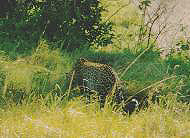 |
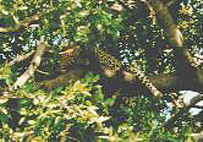 |
Joel had to drive onwards few hundred meters to get on
that elevation and returned to a large tree where two other cars were standing
already. He maneuvered the car so that we could see a large leopard curled
in grass still sleeping. Soon sunrays reached chui's grassy den and the
animal stirred, lifted its head and started its "morning toilette". The
female leopard was huge taking time to lick, nibble and chew the fur thoroughly.
After awhile the animal stretched its body to stand up, walk to another
grassy spot that was still in shadow and curl up to rest on. Never and
never on our many safaris did we see a leopard at such a short distance
of some 5m and for such protracted time. It was a mighty female that had
few cubs but nobody knows where are they now. This beautiful animal thrilled
us - we had a real lucky fortune today and we enjoyed any moment of watching
in the following hour or so. The other two cars moved away as passengers
therein had seen enough but we unanimously decided to stay longer so Joel
brought the car into a better position from where one could view at the
leopard below some 4m away. A little bit further to the left was a large
tree in fork of its two larger branches hung an antelope leopard's last
kill obviously.
 |
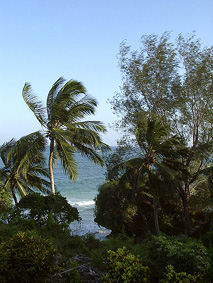 |
More than a half-hour passed so fellow passengers quietly chatted about how long should we still wait until leopard moves again when sunrays reached its present lair again. True it happened again as before but the "morning toilette" lasted a little longer this time. Suddenly the animal got up, stretched and walked away towards the tree disappearing behind its trunk for few moments. Like a ghost it came in view on that large branch, sniffled at the kill and vanished in the foliage. Joel turned and drove back to bellow that tree where the leopard settled on a branch its legs hanging both sides. At first we couldn't see it as the pelt camouflaged it too good within the foliage. Last pictures and recordings made everybody got interested having the brunch soonest. Joel took us to a nice place on a rocky outcrop overlooking the wide savanna stretching up to the horizon and in front some funny growing bushes along a dry brook. The rest of morning was less eventful particularly after viewing at a large leopard at close and for a long time. My safari heart what do you want more! You have seen all BIG FIVES on this safari for the time after such a long waiting.
Back in the camp we had our lunch and a special visitor
who came to say goodbye. The warthog boar came straight to the restaurant
front followed but it whole entourage of three sows and several piglets
of different age. I had to make the last pictures and then it was time
to get into Joel's car bringing us to the Kitchwa Tempo airstrip. Some
3 hours later we were back to Ukunda airport from where we started three
days ago the not forgettable safari of THE BIG FIVE in 2002.